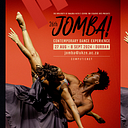Embodied homescapes and somatic journeys: redefining notions of “home”
By Kristi-Leigh Gresse
The JOMBA! Contemporary Dance Experience culminated in a truly delightful and fulfilling finale weekend in Durban. The audience was treated to an unforgettable solo performance entitled “Nothing Personal” by the incredible performer Virva Talonen, who also choreographed the piece. This was followed by another stunning piece entitled “Portable Home” (Chapter Two), a collaborative effort between Durban’s FLATFOOT DANCE COMPANY and Virva Talonen. These two captivating works explored deeply complex themes of home and its multifaceted meanings to different people. The exceptional partnership between the renowned Durban-based FLATFOOT DANCE COMPANY and the exceptional Finnish dance artist and choreographer Virva Talonen was made possible thanks to the generous support of the Finish Embassy in South Africa. This remarkable collaboration no doubt left a lasting impression on those fortunate enough to witness it.
“Nothing Personal” is, ironically, a deeply personal account of Talonen’s journey back to her birthplace in Finland. This work was created in 2018 as a response to the overwhelming nostalgia Talonen felt for her childhood memories. The performance begins with the audience seated in darkness. Talonen’s voice fills the space with a resonant and inviting tone, beckoning the audience to join her on this emotional journey of discovering home. The work is both immersive and reflective. As the performance progresses, Talonen flips a switch on stage, and a beam of light floods the space, illuminating a square of grey blankets surrounding her. The text fades away, leaving only the rhythmic swishing of the light switch, dancing centre stage, a rhythmic pendulum, as the audience is drawn deeper into Talonen’s story.
In the performance, Talonen’s movements were restricted and repetitive, as if trapped within the confines of a simple grey square of duvet inners on the stage floor. However, as the piece progressed and her body became free from this physical limitation, her movements became more fluid and livelier. The entire performance was genuinely intimate and comforting, with Talonen’s emotions effectively conveying the journey of her body becoming familiar with her home’s physical space and her mind becoming at ease with her own body. Through this performance, Talonen reminds us that home isn’t just a physical location but can also be a metaphysical and somatic state of being. It can reside within our minds, bodies and its senses or even in the relationships we hold.
Chapter Two of “Portable Home” is a captivating ensemble piece that was brought to life through the collaboration of several talented individuals, including Jabu Siphika, Sbonga Ndlovu, Sifiso Khumalo, Siseko Duba, Ndumiso “Digga” Dube — all of whom are esteemed members of the FLATFOOT DANCE COMPANY. They are joined for this season of work by Durban’s Kirsty Ndawo, who has performed with the company as a guest dancer across several works. According to Talonen’s program notes, this performance was an integral part of the Portable Home Project, which involved Talonen and her co-collaborator/lighting designer Nanni Vapaavuori, travelling to different parts of the world to work with diverse communities of dancers while exploring the concept of home within their respective contexts.
During the post-performance dialogue, Talonen revealed that this performance was a true reflection of a collaborative process, where all movements were generated by the dancers themselves in response to a prompt. Talonen’s module served as a structure for the dancers to work within, allowing them the freedom to improvise and express themselves within this framework. She made it clear that she does not impose movements upon her dancers but provides them with a platform to respond to the space and their fellow dancers while contributing to the narrative of what home looks and feels like. Overall, “Portable Home” is an intriguing improvisation that showcases the discipline, technique and creativity of its exceptional team of collaborators.
With its deeply intimate and personal nature, the performance resonates within the dancers’ physical surroundings and their very being, pulsing with the diverse mosaic of their ancestral heritages. The festival’s theme, “(In)tangible Heritage”, is embodied in the manifestations and raw emotional responses to the complex and intricate history of the space(s) we call home. Through the performance, the audience is invited to share in the experience with the dancers and explore the multifaceted and nuanced notions of home as they are expressed and extended within and through the body. Vapaavuori eloquently describes the collaborative process with Talonen, emphasising that each collective member contributes their own unique history and experiences, which enrich the creation of the work.
The space in which the performance takes place also plays a significant role in shaping the work and influencing many creative decisions. Though invisible, histories and essences of home are palpably felt and experienced within the body, much like the performance itself.
The pieces entitled “Nothing Personal” and “Portable Home” weave a stunning tapestry that explores meanings of home for individuals hailing from Finland and South Africa. Despite the vast differences in culture and history between these two nations, a shared sentiment emerges in both works: that home is a portable concept that remains with us wherever we venture and that its essence is never truly lost as long as we carry it within us. These performances are truly remarkable and offer a poignant exploration of the concept of home.
